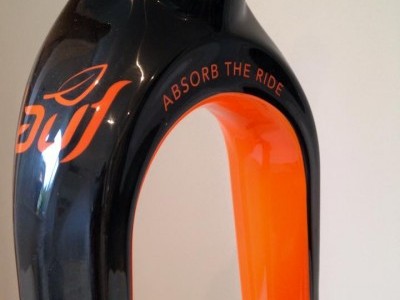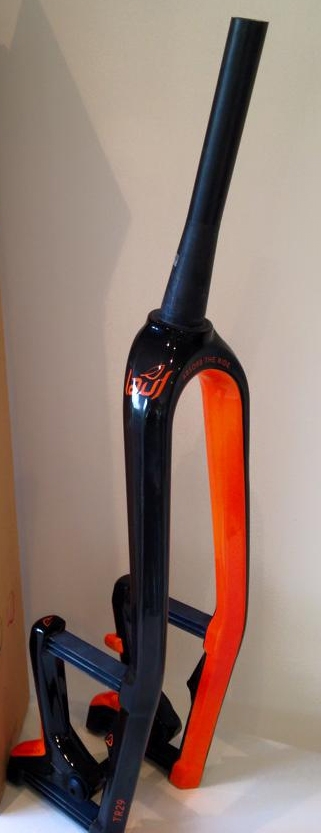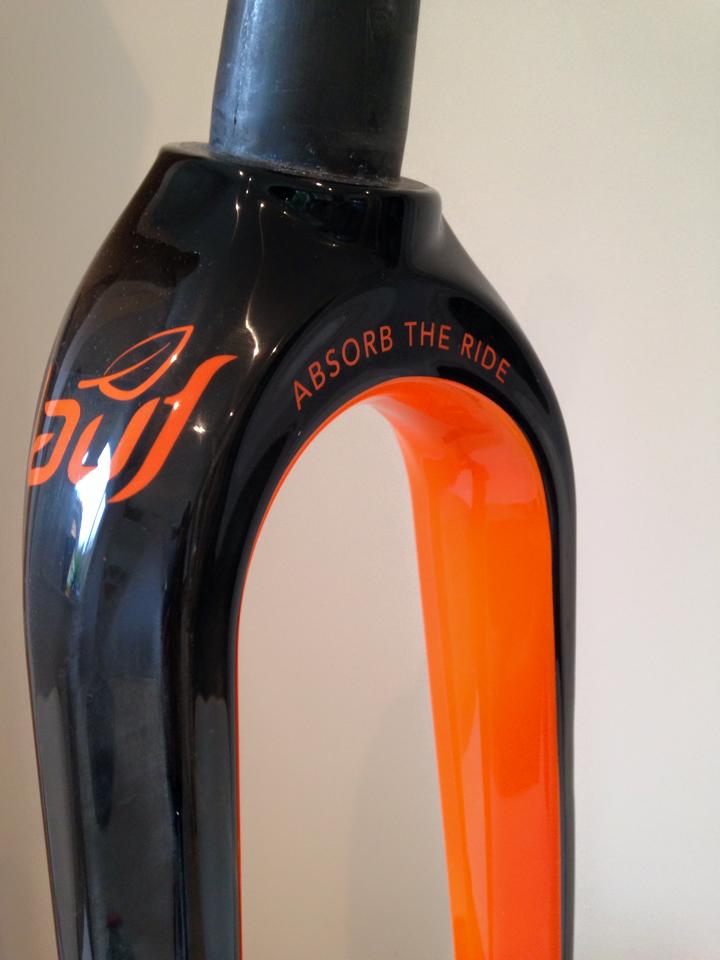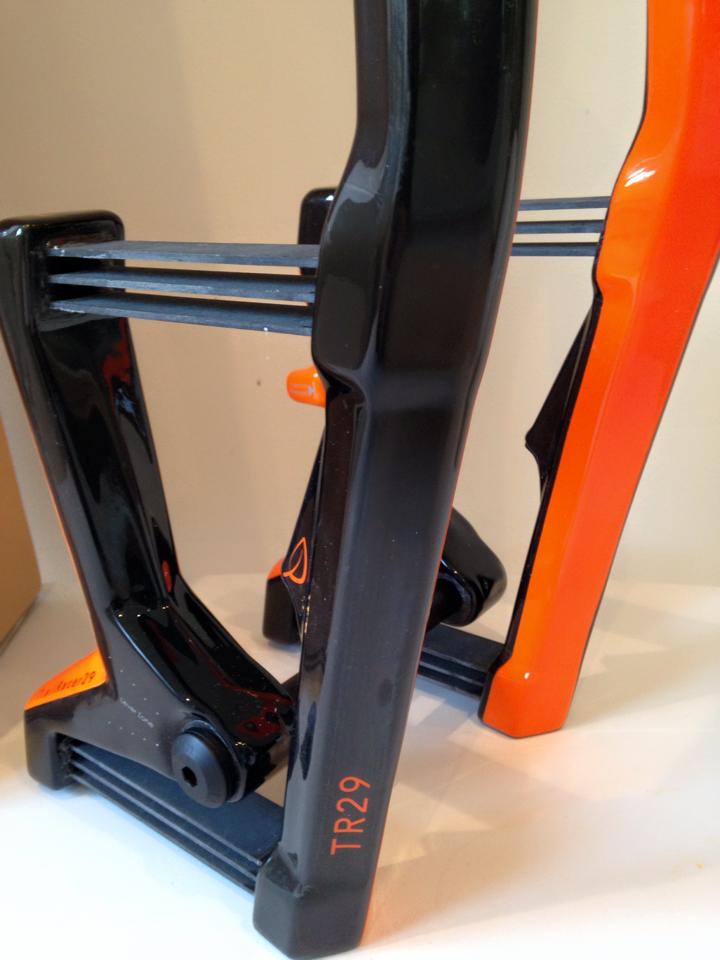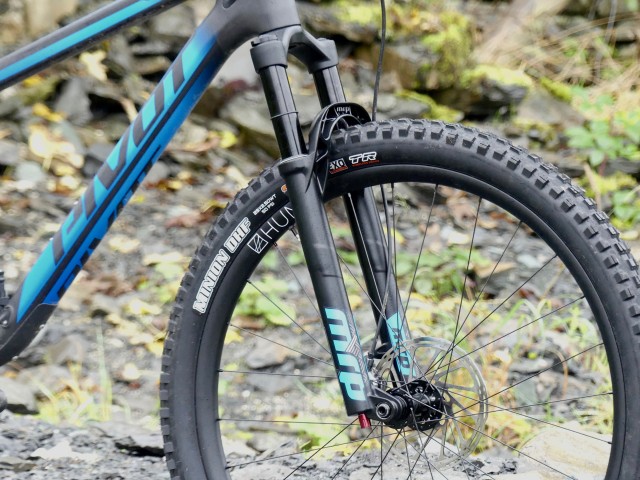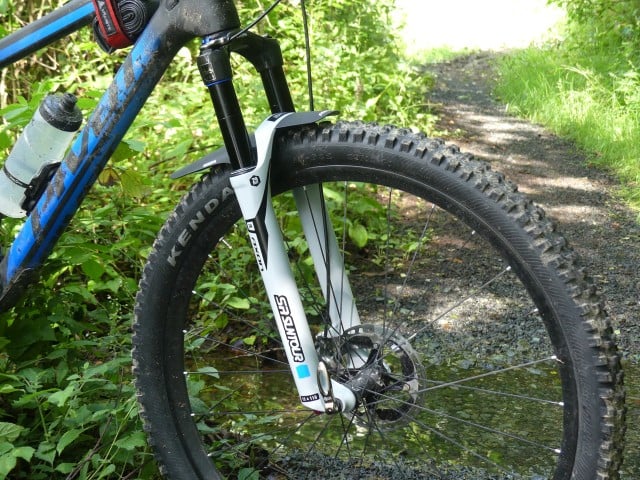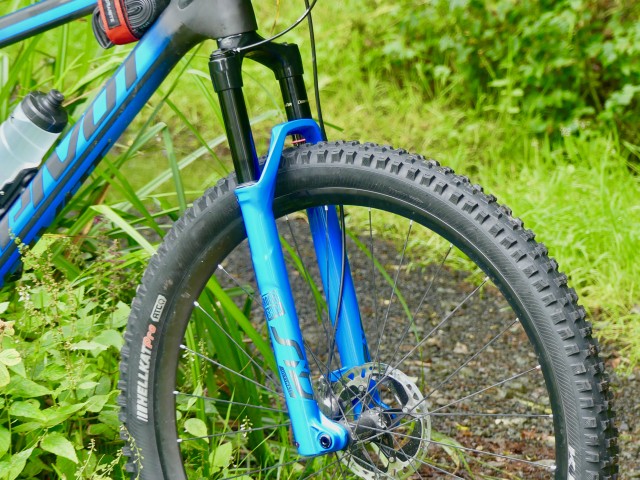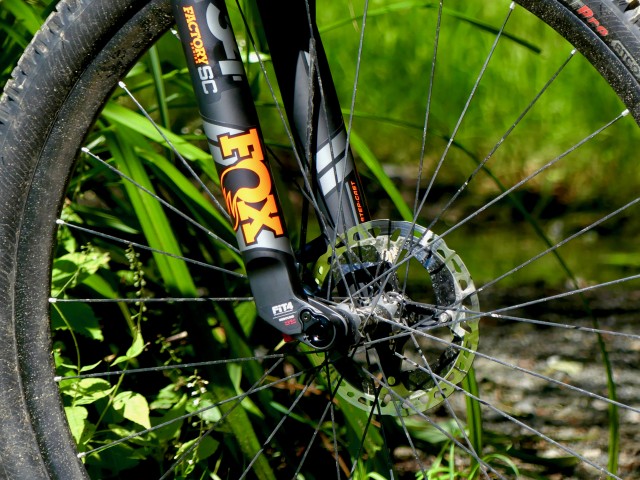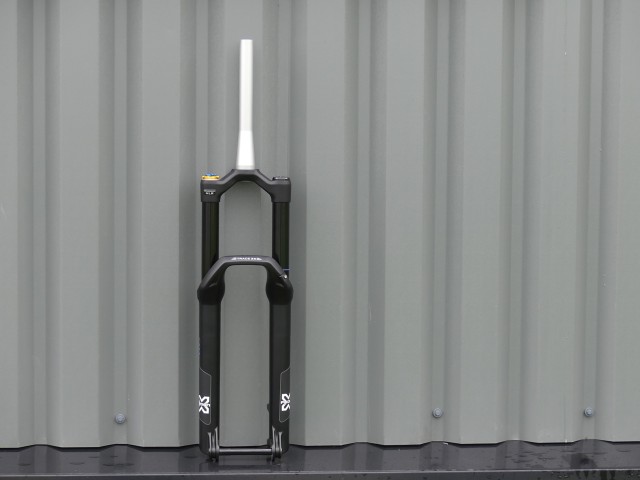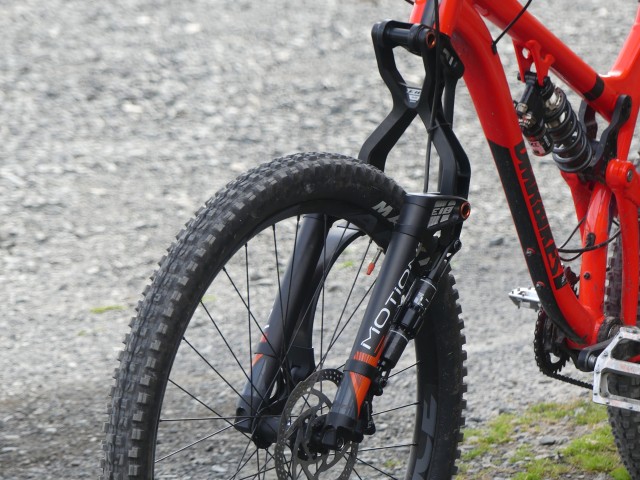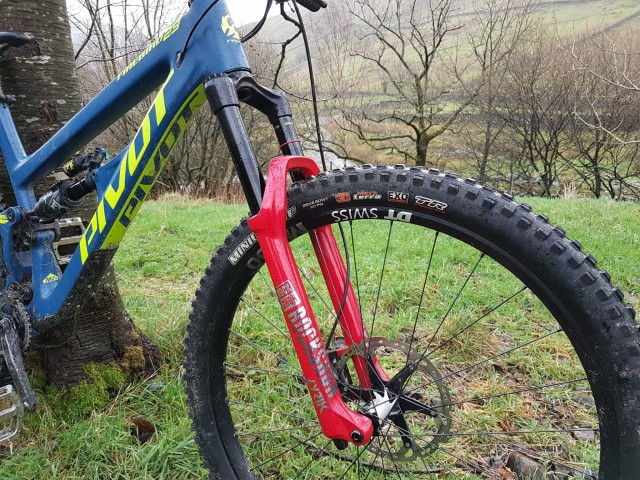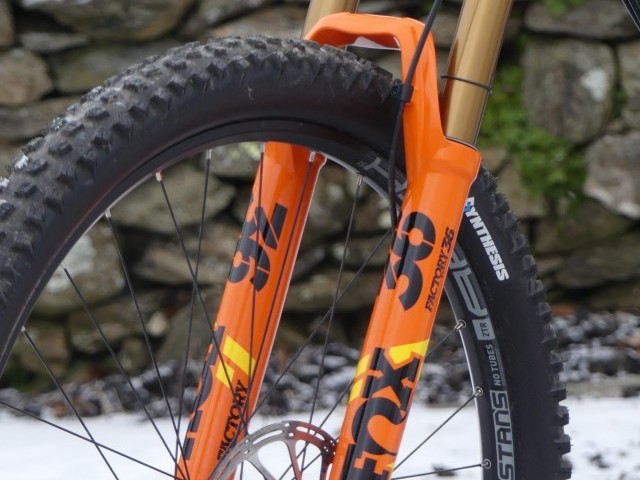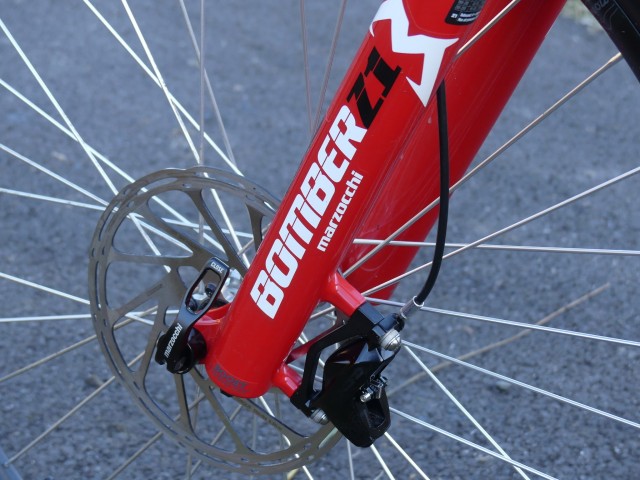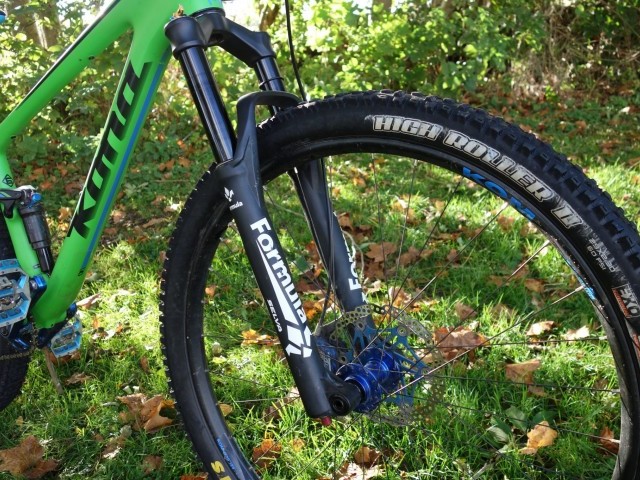At A Glance
Buy Forks on
And now for something completely different! The Lauf Trail Racer is a full carbon build, 996grams on my scales, 60mm of progressively stiffening travel provided by glass fibre spring leafs. Aimed at the XC/marathon rider market where low weight is key, with the added bonus of no maintenance, no seals to worry about, no oil to replenish, no sanctions to get scratched.
The whole package arrives in a well-presented box with the required expander plug and top cap for installation. All you need to supply yourself is a crown race and a mechanism for cutting the carbon steerer down to size. The instructions to accomplish all this is pretty clear so even a first-timer can manage to get these forks fitted in no time.
You can use your own 15mm axle, but the forks come with Lauf’s own one fitted, it’s not quick release – i.e. they need an Allen key but it’s clean tidy and does the job fine. One slightly bizarre thing was the need for a 180mm rotor, pretty large for a fork that’s aimed at people shaving grams off their bike.
On The Trail
The ‘no maintenance’ factor, one of their unique selling points, is all well and good, but the flip side is that there are no parts to tune or fettle with and set up specific to the terrain and rider. Lauf’s answer to this is to supply two flavours, one is for riders over 65kg and the other softer sprung set for riders under 70kg. I’m around 63kg, Lauf originally sent the stiff set saying a lot of riders prefer this set-up anyway, even if your weight is under the threshold. I like my XC forks to be as stiff as possible when locked out, and I do run them locked a lot of the time, but as soft as possible when unlocked. Because of that I wanted to try both sets to get a decent comparison.
First off, I fitted the stiffer set to the KTM Myroon 29er hardtail I’ve been riding for a few months, if you’re like me you will spend the first ten minutes looking at the bike from every angle trying to decide if it all still makes sense. Hanging it on the scales brings a smile; 1.5lbs lighter than the FOX forks that came off and sitting 8mm lower with same wheelbase - thank you very much, I’ll have that!
Pushing down on the fork in the workshop it felt pretty springy, hmmmm, this could be a short test. The trails I wanted to head to were about a 20km road ride away with a bunch of hills. Classic locked-out fork territory, not fun in itself but a necessary evil and a good way to warm up.
Like any new bit on a bike, particularly something as significant as a set of forks, all your riding senses go into overdrive looking for feedback both good and bad. I was trying to gauge if the springy feeling was OK or a real turnoff, to be honest it wasn’t as bad as I expected, and after a few km’s had forgotten about it altogether. Until I hit the hills, my style is up out the saddle wrestling the bars, moving all over the bike. Perhaps not the most efficient but it is what it is, here I did miss the locked out fork. I tried to refine my style a bit, less mashing, more smooth, and it helped quite a lot. One thing I did notice was the lighter front end. I can definitely put up with a bit of movement for the drop in weight.
With the boring road section out of the way it was onto the trails. Initially through some tight twisty, very lumpy and rooty stuff. The fork worked alright, there wasn’t a lot of movement, this is not a plush fork by any means so it’s not going to soak any of this type of trail up at low speeds, but there was a discernible benefit felt from the light front when popping over obstacles.
I was concerned that the way the wheel is held in place with glass fibre springs may cause a large degree of flex and lateral movement, but in reality I felt none of that. Further on came a fast downhill jeep track, again something I’d been down a hundred times before. This is where the fork really made itself known, the surface is pretty rough, small rocks, stones, and small steps. Taken at speed the fork comes alive, reacting to the small fast hits really quickly and smoothing out the ride better than any of my other XC forks, probably only using about 30-40mm of travel but working really well.
I took the bike to Scotland for a number of rides, again all XC type trails, nothing overly gnarly or downhill, that’s not what the forks are aimed at, and to be honest they wouldn’t work well at all in that environment with larger drops, big hits etc. Again, on the fast dual and single track running 24psi on pretty thin 2.0 Specialized FastTracks they felt pretty good.
After a decent amount of rides I swapped to the “light” version for riders up to 70kg. I was worried that they may bob so much I’d hate them. Truth is they didn’t seem to move any more than the stiffer set on flat or climbs, but they were even better on the fast semi-rough trails. The fact there is no stiction, no seals to push past, no friction really did mean that they respond to fast small hits incredibly well, the faster you go the better they work.
The slightly softer setting does, in my opinion, work better at doing fork stuff, smoothing out the hits, for my weight anyway. Bob is there on climbs but it’s not too bad and not nearly as bad as a set of normal 100mm travel forks not locked out. There is a spring to them, but this can be used to your advantage in many situations to help pop the front end up.
One area I did feel they suffered was at a cross-country race where there were a few bomb holes where the compression was pretty harsh, if I was running my normal fork I’d consider locking it out just to give me a stiff platform to help control the transition at the bottom, here the fork probably got close to its travel and did feel pretty unstable, after the first time through I was able to compensate for it a bit.
Overall
To get the best out of these forks they have to be used against the job spec “fast XC and marathon”. On fast, semi-rough terrain, at speed you feel the benefit the most. They feel better than rigid forks, and the weight saving is a plus against regular forks. They suit hardtail bikes, if the course deserves a full suss then you really would be looking at a normal fork up front with a bit more travel. Yet on the fast smoother stuff that you see on some of the European marathons these would be perfect.
Buy Forks on
This review was in Issue 35 of IMB.
For more information visit Lauf ForksRelated
By Derek Wilson

